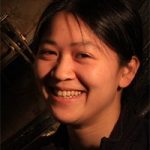Three new professors join the CRAQ
The Centre for Research in Astrophysics of Quebec (CRAQ) welcomes three new professors. Hsin Cynthia Chang, Adrian Liu and Jonathan Sievers joined the astrophysics group at McGill University, in August 2018.
 Hsin Cynthia Chiang is an Associate Professor. She holds a bachelor’s degree in physics from the University of Illinois at Urbana-Champaign (2002) and a doctorate from Caltech (2009). She was a Dicke Postdoctoral Fellow at Princeton University. She also spent a year working at Amundsen-Scott South Pole station as a winter scientist. From 2013 to 2018, she was a senior lecturer at the University of KwaZulu-Natal in Durban, South Africa.
Hsin Cynthia Chiang is an Associate Professor. She holds a bachelor’s degree in physics from the University of Illinois at Urbana-Champaign (2002) and a doctorate from Caltech (2009). She was a Dicke Postdoctoral Fellow at Princeton University. She also spent a year working at Amundsen-Scott South Pole station as a winter scientist. From 2013 to 2018, she was a senior lecturer at the University of KwaZulu-Natal in Durban, South Africa.
Her research focuses on observational cosmology, more specifically high-precision measurements of the redshifted 21-cm emission from neutral hydrogen and the temperature and polarization anisotropies of the cosmic microwave background radiation. She is also interested in the development of instruments and data analysis spanning ground-, balloon- and satellite-based platforms.
 Adrian Liu is an Assistant Professor. He obtained a bachelor’s degree in physics from Princeton University in 2006 and completed a doctorate at MIT in 2012. From 2012 to 2018, he completed a first postdoctoral fellowship as a BCCP Fellow at UC Berkeley and a second as a Hubble Fellow at the same institution.
Adrian Liu is an Assistant Professor. He obtained a bachelor’s degree in physics from Princeton University in 2006 and completed a doctorate at MIT in 2012. From 2012 to 2018, he completed a first postdoctoral fellowship as a BCCP Fellow at UC Berkeley and a second as a Hubble Fellow at the same institution.
Adrian Liu’s research is focused on making the largest-ever three-dimensional map of our Universe. He concentrates on the period when the first stars and galaxies formed, the Cosmic Dawn, when matter condensed into first-generation stars and galaxies. This is done by mapping the distribution of neutral hydrogen atoms, since it is ubiquitous in space and conveniently emits faint radio waves. Therefore, observations with large radio telescopes enable the construction of such a map.
 Jonathan Sievers is an Assistant Professor. He graduated from MIT in 1997 with bachelor’s degrees in Physics and Math and a minor in Music. He then went on to earn a PhD in Astronomy from Caltech. After a postdoctoral fellowship at the Canadian Institute of Theoretical Astrophysics, he spent two years as an associate research scholar at Princeton University. Between 2013 and 2018, Sievers has been a Research Professor at the University of KwaZulu-Natal in South Africa, where he led the creation of a massive telescope array, known as HIRAX. The aim of this 25-institution, international collaboration is to map the sky of the Southern Hemisphere in much the same way that CHIME is mapping the northern sky.
Jonathan Sievers is an Assistant Professor. He graduated from MIT in 1997 with bachelor’s degrees in Physics and Math and a minor in Music. He then went on to earn a PhD in Astronomy from Caltech. After a postdoctoral fellowship at the Canadian Institute of Theoretical Astrophysics, he spent two years as an associate research scholar at Princeton University. Between 2013 and 2018, Sievers has been a Research Professor at the University of KwaZulu-Natal in South Africa, where he led the creation of a massive telescope array, known as HIRAX. The aim of this 25-institution, international collaboration is to map the sky of the Southern Hemisphere in much the same way that CHIME is mapping the northern sky.
The arrival of Jonathan Sievers at McGill, as Canada-150 Chair in Theoretical and Observational Cosmology, will cement existing collaborations between CHIME and HIRAX scientists. Professor Sievers is considered a leader in the study of galaxy clusters – vast clumps of galaxies bound together by gravity. He was also one of the lead authors on a landmark 2015 Nature paper on the recently discovered and mysterious cosmic phenomenon known as fast radio bursts (FRBs).
